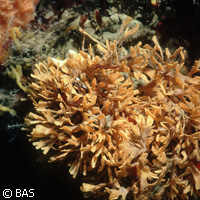Tiny marine creatures offer clues to early Antarctic seaway
The West Antarctic Ice Sheet (WAIS), which is currently over 2,400 kilometres (km) wide and 1.6 km thick, was an open ocean passage as recently as 125,000 years ago, new research from the British Antarctic Survey (BAS) shows. The BAS scientists say tiny marine filter feeders found on either side of the ice sheet provide insight on the stability of the WAIS, an area that experts believe is vulnerable to collapse. The study's findings are published in the journal Global Change Biology. Marine filter feeders are sea creatures that obtain nourishment by filtering particles of food from the water in which they live. The BAS team, working on a study for the Census of Antarctic Marine Life (CAML), assessed colonies of bryozoans (also known as moss animals) living on the seabed in coastal and deep sea regions around Antarctica and other points. Their work led to the discovery of similar species of bryozoans living on the continental shelves of the Ross and Weddell seas, which are currently separated by the huge block of ice that is the WAIS. The researchers believe that these creatures made their homes in each area thanks to an open ocean passage - the trans-Antarctic seaway. According to the team, it's quite possible that an interglacial warm period was responsible for opening up the seaway as recently as 125,000 years ago when the sea level was some 5 metres higher than today. Despite geological evidence hinting of a collapse of the WAIS at some point in the last 1 million years, the question of how often collapses have occurred weighs on the minds of researchers. They want to establish the frequency of collapses and understand the processes and connections between warm periods and deglaciation events. The scientists point out that marine creatures around the continent that could have provided information as to exactly when West Antarctica was free of ice were wiped out during ice ages when glaciers pushed their fossilised remains off the continental shelf. The team says this latest finding could fuel glaciological explorations targeting the future stability of the WAIS. According to the researchers, the WAIS could potentially affect the rate of the sea level rise in centuries to come. A full collapse of the WAIS would boost the global sea level anywhere between 3.3 metres to 5 metres. Some experts even suggest that the WAIS will collapse within the next 4,000 to 7,000 years. 'The WAIS can be considered the Achilles heel of Antarctica and because any collapse will have implications for future sea level rise, it's important that scientists get a better understanding of big deglaciation events. This biological evidence is one of the novel ways that we look for clues that help us reconstruct Antarctica's ice sheet history,' explained BAS' Dr David Barnes, who is the lead author of the paper. 'When we found groups of strikingly similar bryozoans hundreds of miles apart, we knew we were onto something very interesting. Perhaps these species had survived the last ice age whereas in all other regions of Antarctica they were wiped out. We know that after the last ice age groups of bryozoans dispersed freely between many of the regions we studied,' he added. 'But because the larvae of these animals sink and this stage of their life is short - and the adult form anchors itself to the seabed - it's very unlikely that they would have dispersed the long distances carried by ocean currents.' The colonisation of these two regions is an indication that both the Ross and Weddell seas were linked by a trans-Antarctic seaway in the recent past, the researchers concluded.
Countries
United Kingdom



